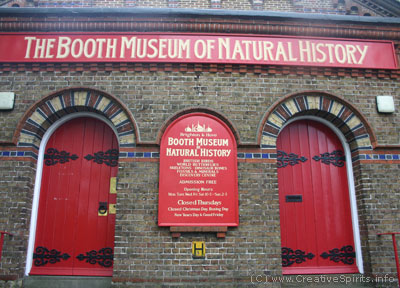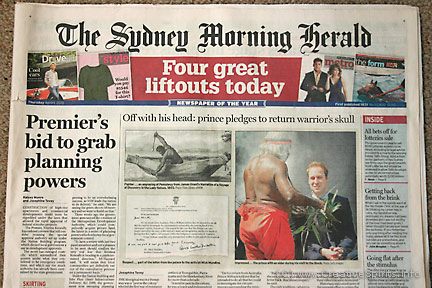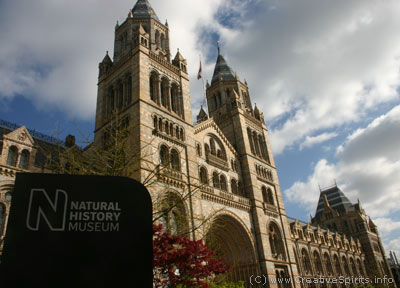Aboriginal timeline: Remains repatriation
Found 47 results for your search. Showing page 2 of 3.
2009
-
Booth Museum of Natural History, Brighton, Britain promises to repatriate two skulls and two thigh bones, donated almost 100 years ago [1]. The museum also holds a Ngarrindjeri skull which has been turned into a water carrier and is considered 'extremely rare' [2]. The skull is with the museum since 1925 when it was donated by a local collector.

Booth Museum of Natural History, Brighton. Even small museums hold Aboriginal remains which were often donated by private collectors. -
Seattle Art Museum, USA is the first US institution that independently initiates a repatriation. It promises to return 'a sacred Aboriginal object' to its traditional land in central Australia and to consult with central Australian elders and representatives [3].
-
The University College, London, UK, hands over the skulls of three individuals from Victoria's Gunditjmara community and another from the Dja Dja Wurrung nation [4]. It is the first repatriation to Victoria.
-
The Australian government and the Leiden University Medical Center (Netherlands) agree to repatriate the remains of five Bundjalung people (Northern Rivers region of NSW) which were acquired by the Dutch in 1882. [5]
2010
-
During a visit to Australia, Prince William takes up a request to return Aboriginal warrior Pemulwuy's remains to Redfern (Sydney), making front page news.

Aboriginal remains repatriation on the front page of a newspaper. This is a rare occasion and came about when Aboriginal activist Mick Mundine received an answer from Prince William to the letter he had written asking for the whereabouts of some remains. [6] -
The National Museum of Natural History, Washington DC, USA returns Aboriginal remains taken from their burial places during the 1948 American-Australian Scientific Expedition to Arnhem Land (Northern Territory) [7].
-
The ancestral remains of an Erup (Darnley Island) child return, 161 years after they were taken to the UK. The remains were first acquired by Captain Owen Stanley in 1849 during a visit to Darnley Island, then passed on to an antiquarian who gave them to the Norwich Castle Museum in 1854. Finally, the World Museum Liverpool received the remains in 1956. [8]
2011
-
The Natural History Museum, London, UK announces to return remains to the Torres Strait which it had bought from a dealer in 1884 but could not date. This return would be the largest repatriation of remains to Australia [9].

Natural History Museum, London. Reluctantly, the museum let go some Aboriginal remains. Many more are stored in its vast halls, believed to have been transferred there for safekeeping from the Royal College of Surgeons while London was being bombed during World War II [10].
2012
-
The Martin-Luther University, Halle, Germany announces to return 4 skeletons and 3 skulls to Australia, but does not give a date [11].
2013
-
The Charité Medical Museum in Berlin returns remains of 33 individuals, the first return of Aboriginal remains from Germany [12]. As the first German scientific institution, Charité in November 2008 signed an agreement with Australia for a "dignified burial" of Aboriginal remains.
-
The Queensland Museum in Brisbane returns remains of Aboriginal people to the Balonne River region.
2014
-
The federal government-appointed Advisory Committee for Indigenous Repatriation hands over its National Resting Place Consultation report, recommending a keeping place for Aboriginal remains that could not be returned to country. [13]
-
The Charité Medical Museum returns 14 skulls of Aboriginal people to representatives of the Goemulgal, Lag Mabuyag and Wajarri Yamatji peoples. It also repatriated remains to Namibia (2011 and 2014) and to Paraguay (2012).
-
France and Australia sign an agreement on the repatriation of remains. A joint expert committee will help identify the origin of Aboriginal Australian remains held in France.
2015
-
Museum Victoria returns the skull of Jim Crow, believed to have been a member of the Wonnarua people of the Hunter Valley. The skull was stolen from his grave in the early 1860s and later stored on Museum Victoria shelves for 126 years. [14]
-
The Australian National University returns the bones of Mungo Man, 40 years after their discovery.
-
Kenneth Dickson, an Elder of the Dunghutti community in NSW, accepts in Hampshire, UK, the remains of a man believed to be aged between 21 and middle age, who was removed originally from Delicate Nobby, near Kempsey, and later donated to the Hampshire County Council Museums Service.[15]
2017
-
After more than 40 years away from country at the Australian National University in Canberra, the remains of Mungo Man (the oldest Aboriginal remains discovered at Lake Mungo), along with those of around 100 other Aboriginal people, return home to his ancestral homelands of the Mutti Mutti, Ngiyampaa and Paakantji peoples. [16]
2019
-
The German state of Baden-Württemberg intends to return ten identified Aboriginal skulls stored at the Albert Ludwigs University in Freiburg.
-
Elders bury the remains of 11 Kaurna people in the Glenelg area, SA, which had returned to country from the UK to Canberra earlier this year. The remains of another 800 Kaurna people are still in storage at SA Museum warehouses. [17]
References
View article sources (0)
[15207] 'Coming home', Koori Mail 442 p.14
[15207a] 'Government urges Aboriginal skull return', Koori Mail 445 p.19
[15210] 'Sacred Aboriginal object returned from USA', NIT online, nit.com.au/story.aspx?id=18120
[15212] 'Etchings talks begin in UK', NIT 6/8/2009 p.12
[15214] 'Indigenous remains to be returned from Netherlands', Media statement, Australian government, 28/9/2009
[15222] Sydney Morning Herald, 1/4/2010
[15218] 'More on the way home', Koori Mail 480 p.11
[15220] 'An Erub child home at last', Koori Mail 486 p.11
[15225] 'Etchings talks begin in UK', NIT 6/8/2009 p.12
[15225a] 'Remains coming home', Koori Mail 497 p.9
[15228] 'Martin-Luther-Universität gibt Skelette an die Aborigines zurück', Die Welt 27/10/2012
[15230] 'Indigenous Remains To Come Home From Germany', artsHub, 22/4/2013, au.artshub.com/au/news-article/news/arts/indigenous-remains-to-come-home-from-germany-195097, retrieved 30/4/2013
[15234] 'The government must bring the stolen Indigenous dead home', The Guardian 5/10/2017
[15240] 'Book tells of 19th century body-snatching and skull collecting', The Age 20/6/2015
[15242] 'Delicate Nobby Man Comes Home', Aboriginal Art Directory 14/11/2015
[15246] 'Mungo Man finally home with his ancestors', NITV 19/11/2017
[18309] 'Ancestral remains of the Kaurna people returned to country from UK in emotional Adelaide ceremony', ABC News 1/8/2019


